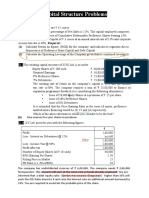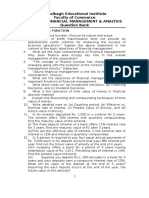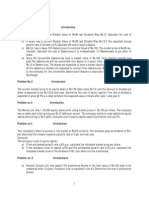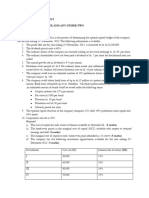Capital Structure
Capital Structure
Uploaded by
Prashanth MagadumCopyright:
Available Formats
Capital Structure
Capital Structure
Uploaded by
Prashanth MagadumOriginal Description:
Copyright
Available Formats
Share this document
Did you find this document useful?
Is this content inappropriate?
Copyright:
Available Formats
Capital Structure
Capital Structure
Uploaded by
Prashanth MagadumCopyright:
Available Formats
AFM M.
Com
AIMS IHE
M.Com ( I semester) : 2018-19
Advanced Financial Management (AFM)
Module : 01 : Financing Decision
Problems on EBIT-EPS Analysis:
Problem : 01
A Company’s capital structure consists of the following :
Equity share of ₹ 100 each ₹ 20 lakhs
Retained earnings ₹ 10 lakhs
9% preference shares ₹ 12 lakhs
7% Debentures ₹ 8 lakhs
Total ₹ 50 lakhs
The company earns 12% on its capital. The income tax rate is 50%. The company requires a sum of ₹ 25
lakh to finance its expansion programme for which the following alternatives are available to it:
(i) Issue of 20,000 equity shares at a premium of ₹ 25 per share.
(ii) Issue of 10% preference shares.
(iii) Issue of 8% debentures.
It is estimated that the P/E ratio in the cases of equity, preference and debentures financing would be
21, 4, 17 and 15.7 respectively.
Problem : 02 : 2015 : sec - B
The balance sheet of Alpha Numeric Company is given below:
Liabilities ₹ Assets ₹
Equity capital (₹ 10 per share) 90,000 Net fixed assets 2,25,000
10% Long term debt 1,20,000 Current assets 75,000
Retained earning 30,000
Current liabilities 60,000
3,00,000 3,00,000
The company’s total assets turnover ratio is 3, its fixed operating cost is ₹ 1,50,000 and its variable
operating cost ratio is 50%. The income tax rate is 50%.
You are required to:
(i) Calculate the different types of leverages for the company.
(ii) Determine the likely level of EBIT if EPS is: a) ₹ 1 b) ₹ 2 c) ₹ 0
Sangeetha S, M.Com - NET, KSET
Assistant Professor, AIMS IHE
Peenya, Bangalore
sangpmagadum18@gmail.com Page 1
AFM M.Com
Problem : 03 :
The balance sheet of DJ Company is given below:
Liabilities ₹ Assets ₹
Equity capital (₹ 10 per share) 60,000 Net fixed assets 1,50,000
10% Debentures 80,000 Current assets 50,000
Retained earning 20,000
Current liabilities 40,000
2,00,000 2,00,000
The company’s total assets turnover ratio is 3, its fixed operating cost is ₹ 1,00,000 and its variable
operating cost ratio is 40%. The income tax rate is 50%.
You are required to:
(i) Calculate the different types of leverages for the company.
(ii) Determine the likely level of EBIT if EPS is 5
Problem : 04
Vishal limited is setting up a project with a capital outlay of ₹ 60,00,000. It has two alternatives in
financing the project cost.
Alternative I : 100 % equity finance by issuing equity shares of ₹ 10 each.
Alternative II : Debt-equity ratio 2:1 (issuing equity shares of ₹ 10 each)
The rate of interest payable on the debts is 18% p.a. the corporate tax rate is 40%. Calculate the
indifference point between the two alternative methods of financing.
Problem : 05
Ganapathi Ltd. is considering three financing plans. The key information is as follows:
a) Total investment to be raised ₹ 2,00,000
b) Plans of financial proportion:
Plans Equity Debt Preference shares
A 100% - -
B 50% 50% -
C 50% - 50%
c) Cost of debt 8%
Cost of preference shares 8%
d) Tax rate 50%
e) Equity shares of the face value of ₹ 10 each will be issued at a premium of ₹ 10 per share.
f) Expected EBIT is ₹ 80,000
You are required to determine for each plan:-
(i) Earnings per share (EPS)
(ii) The financial break-even point
(iii) Indicate if any of the plans dominate band compute the EBIT range among the plans for
indifference.
Sangeetha S, M.Com - NET, KSET
Assistant Professor, AIMS IHE
Peenya, Bangalore
sangpmagadum18@gmail.com Page 2
AFM M.Com
Problem : 06 : 2018 : sec - C
Paramount Produces Ltd. wants to raise ₹ 100 lakhs for a diversification project. Current estimate of
earnings before interest and taxes (EBIT) from the new project is ₹ 22 lakhs per annum.
Cost of debt will be 15% for amounts up to and including ₹ 40 lakhs, 16% for additional amounts up to
and including ₹ 50 lakhs and 18% for additional amounts above ₹ 50 lakhs.
The equity shares (face value ₹ 10) of the company have a current market value of ₹ 40. This is expected
to fall to ₹ 32 if debts exceeding ₹ 50 lakhs are raised.
The following options are under consideration of the company :
Plans Equity Debt
I 50% 50%
II 60% 40%
III 40% 60%
Determine the earnings per share (EPS) for each option and state which option the company should
exercise. Tax rate applicable to the company is 50%.
Problem : 07
Yoyo Limited presently has ₹ 36,00,000 in debt outstanding bearing an interest rate of 10 %. It wishes to
finance a ₹ 40,00,000 expansion programme and is considering three alternatives: additional debt at
12% interest, preference shares with an 11 % dividend, and the issue of equity shares at 16% share. The
company presently has 8,00,000 shares outstanding and is in a 40% tax bracket. If earnings before
interest and taxes are presently ₹ 15,00,000, what would be earnings per share for the three
alternatives, assuming no immediate increase in profitability?
Problem : 08 :
Alpha Limited requires funds amounting to ₹ 80 lakh for its new project. To raise the funds, the company
has following two alternatives:
(i) To issue Equity shares of ₹ 100 each (at par) amounting to ₹ 60 lakh and borrow the balance
amount at the interest of 12% p.a. or
(ii) To issue equity shares of ₹ 100 each (at par) and 12 % debentures in equal proportion.
The income- tax rate is 30%.
Find out the point of indifference between the available two modes of financing and state which
option will be beneficial in different situations.
Sangeetha S, M.Com - NET, KSET
Assistant Professor, AIMS IHE
Peenya, Bangalore
sangpmagadum18@gmail.com Page 3
AFM M.Com
Problems on Capital Structure theories :
A. Net Income approach (NI)
Problem : 01
Rupa Ltd.’s EBIT is ₹ 5,00,000. The company has 10%, ₹ 20,00,000 debentures. The equity capitalization
rate i.e. Ke is 16%. You are required to calculate : (i) market value of equity and value of firm (ii) overall
cost of capital.
Problem : 02
X Ltd. is expecting an annual EBIT of ₹ 1 lakh. The company has ₹ 4 lakhs in 10% debentures. The cost of
equity capital or capitalization rate is 12.5%. you are required to calculate the total value of the firm
according to the Net Income approach.
Problem : 03
a) A company expects a net income of ₹ 80,000. It has ₹ 2,00,000, 8% Debentures. The equity
capitalization rate of the company is 10%. Calculate the value of the firm and overall
capitalization rate according to the Net Income approach (ignoring income tax)
b) If the debenture debt is increased to ₹ 3,00,000, what shall be the value of the firm and the
overall capitalization rate?
B. Traditional approach:
Problem : 04
Indra Ltd. has EBIT of ₹ 1,00,000. The company makes us debt and equity capital. The firm has 10%
debentures of 5,00,000 and the firm’s equity capitalization rate is 15%. You are required to compute: (i)
Current value of the firm (ii) Overall cost of capital.
Problem : 05
A company’s current net operating income (EBIT) is ₹ 8,00,000. The company has ₹ 20 lakhs of 10% debt
outstanding. Its equity capitalization rate is 15%. The company is considering to increase its debt by
raising additional ₹ 10 lakhs and to utilize these funds to retire the amount of equity. However , due to
increased financial risk, the cost of entire debt is likely to increase to 12% and the cost of equity is 18%.
You are required to compute the market value of the company using traditional model and also make
recommendations regarding the proposal.
C. Net Operating Income approach (NOI)
Problem : 06
Amita Ltd’s operating income is ₹ 5,00,000. The firm’s cost of debt is 10% and currently the firm employs
₹ 15,00,000 of debt. The overall cost of capital of the firm is 15%. You are required to determine: (i) total
value of the firm (ii) cost of equity.
Sangeetha S, M.Com - NET, KSET
Assistant Professor, AIMS IHE
Peenya, Bangalore
sangpmagadum18@gmail.com Page 4
AFM M.Com
Problem : 07
ABC company expects a net operating income of ₹ 1,00,000. It has ₹ 5,00,000, 6% debentures. The
overall capitalization rate is 10%. Calculate the value of the firm and the equity capitalization rate (cost
of equity) according to the net operating income approach. If the debentures debt is increased to ₹
7,50,000. What will be the effect on value of the firm and the equity capitalization rate?
Problem : 08 : 2015 : sec-B
XYZ expects a net operating income of ₹ 2,00,000. It has 8,00,000, 6% debentures. The overall
capitalization rate is 10%. Calculate the value of the firm and the equity capitalization rate (cost of
equity) according to the net operating income approach. If the debentures debt is increased to ₹
10,00,000. What will be the effect on value of the firm and the equity capitalization rate?
Problem : 09 : 2016 : sec -B
There are two firms ‘A’ and ‘B’ which are exactly identical except that A does not use any debt in its
financing, while B has ₹ 2,50,000, 6% debentures in its financing. Both the firms have earnings before
interest and tax of ₹ 75,000 and the equity capitalization rate is 10%. Assuming the corporation tax is
50%, calculate the value of the firm.
Problem : 10
Companies X and Y are identical in all respects including risk factors except for debt/equity, X having
issued 10% debentures of ₹ 18 lakhs while Y has issued only equity. Both the companies earn 20%
before interest and taxes on their total assets of ₹ 30 lakhs. Assuming a tax rate of 50% and
capitalization rate of 15% for an all-equity company, compute the value of companies X and Y using (i)
net income approach (ii) net operating income approach.
Problem : 11
Alpha Ltd. and Beta Ltd. are identical except for capital structures. Alpha Ltd. has 50 per cent debt and
50 per cent equity, whereas Beta Ltd. has 20 per cent debt and 80 per cent equity. (all percentages are
in market-value terms). The borrowing rate for both companies is 8 per cent in a no – tax world, and
capital markets are assumed to be perfect.
a) (i) if you own 2 per cent of the shares of Alpha Ltd., what is your return if the company has net
operating income of ₹ 3,60,000 and the overall capitalization rate of the company, Ko is 18 per
cent? (ii) What is the implied required rate of return on equity?
b) Beta Ltd. has the same net operating income as Alpha Ltd. (i) what is the implied required equity
return of Beta Ltd.? (ii) why does it differ from that of Alpha Ltd.?
Problem : 12
S.R Ltd. expects annual net operating income of ₹ 2,00,000. It has ₹ 5,00,000 outstanding debt, cost of
debt is 10%. If the overall capitalization rate is 12.5% What would be the total value of the firm and the
equity capitalization rate according to the Net operating income approach.
Sangeetha S, M.Com - NET, KSET
Assistant Professor, AIMS IHE
Peenya, Bangalore
sangpmagadum18@gmail.com Page 5
AFM M.Com
What will be the effect of the following on the total value of the firm and the equity capitalization rate, if
: (i) the firm increases the amount of debt from ₹ 5,00,000 to ₹ 7,50,000 and uses the proceeds of the
debt to repurchase equity shares. (ii) the firm redeems debt of ₹ 2,50,000 by issuing fresh equity shares
of the same amount.
D. Modigliani – Miller approach (MM)
Problem : 13 : When value of levered firm is more than the value of unlevered firm
There are two company N Ltd. and M Ltd. having same earnings before interest and taxes i.e. EBIT of ₹
20,000. M Ltd is a levered company having a debt of ₹ 1,00,000 @ 7% rate of interest. The cost of equity
of N Ltd. is 10% and of M Ltd. is 11.50%. Find out how arbitrage process will be carried on?
Problem : 14 : When value of Unlevered firm is more than the value of levered firm
There are two company N Ltd. and M Ltd. having same NOI of ₹ 20,000 except that L Ltd. is a levered
company having a debt of ₹ 1,00,000 @ 7% and cost of equity of U Ltd. & L Ltd. are 10% and 18%
respectively. Show how arbitrage process will work.
Problem : 15
X company has EBIT of ₹ 1,00,000. It expects a return on its investment at a rate of 12.5%. you are
required to find out the total value of the firm according to the Miller-Modigliani theory.
Problem : 16
There are two firms X and Y which are exactly identical except that X does not use any debt in its
financing, while Y has ₹ 1,00,000 5% Debentures in its financing. Both the firms have EBIT of ₹ 25,000
and the equity capitalization rate is 10%. Assuming the corporation tax of 50% calculate the value of the
firm using M & M approach.
Problem : 17 : 2017 : Sec -B
Companies U and L are identical in every respect except that the former does not use debt in its capital
structure, while the latter employs ₹ 6,00,000 10% debt. Assuming that (i) all the M-M assumptions are
met, (ii) the corporate tax rate is 35% (iii) the EBIT is ₹ 1,20,000, and (iv) the equity capitalization of the
unleveled company is 0.20. what will be the value of the firms U and L?
Problem : 18
Firms X and Y are identical in every respect except that Y is levered while X is unlevered. Company Y has
₹ 20,00,000 8% debentures outstanding.. Assuming that (i) all the M-M assumptions are met, (ii) the
corporate tax rate is 50% (iii) the EBIT is ₹ 6,00,000, and (iv) the equity capitalization rate for company Y
is 10%. what will be the value of the firms according to MM approach?
Sangeetha S, M.Com - NET, KSET
Assistant Professor, AIMS IHE
Peenya, Bangalore
sangpmagadum18@gmail.com Page 6
AFM M.Com
Problem : 19
The following is the data regarding two companies ‘A’ and ‘B’ belonging to the same equivalent risk
class:
Company A Company B
Number of ordinary shares 1,00,000 1,50,000
8% Debentures 50,000 -
Market price per share ₹ 1.30 ₹ 1.00
Profit before interest ₹ 20,000 ₹ 20,000
All profits after paying debenture interest are distributed as dividends. You are required to explain how
under Modigliani and Miller approach, an investor holding 10% of shares in company ‘A’ will be better
off in switching his holding to company ‘B’.
Problem : 20 : 2018 Sec- C
The following is the data regarding two companies ‘X’ and ‘Y’ belonging to the same equivalent risk
class:
Company A Company B
Number of ordinary shares 90,000 1,50,000
6% Debentures 60,000 -
Market price per share ₹ 1.20 ₹ 1.00
Profit before interest ₹ 18,000 ₹ 18,000
All profits after paying debenture interest are distributed as dividends. You are required to explain how
under Modigliani and Miller approach, an investor holding 10% of shares in company ‘X’ will be better
off in switching his holding to company ‘Y’.
Sangeetha S, M.Com - NET, KSET
Assistant Professor, AIMS IHE
Peenya, Bangalore
sangpmagadum18@gmail.com Page 7
You might also like
- Jackson Automotive Systems ExcelDocument5 pagesJackson Automotive Systems Excelonyechi2004No ratings yet
- Capital StructureDocument7 pagesCapital StructureKhushi RaniNo ratings yet
- CA Intermediate Mock Test Eco FM 16.10.2018 EM Only QuestionDocument6 pagesCA Intermediate Mock Test Eco FM 16.10.2018 EM Only QuestionTanmayNo ratings yet
- Capital Structure PDFDocument3 pagesCapital Structure PDFnikitaNo ratings yet
- Board of Studies Academic Capital Structure Questions 1649402823Document6 pagesBoard of Studies Academic Capital Structure Questions 1649402823Arundhathi MNo ratings yet
- Capital Structure Problems AssignmentDocument3 pagesCapital Structure Problems AssignmentRamya Gowda100% (2)
- 41 Capital Structure 1728640417Document3 pages41 Capital Structure 1728640417madhu.r3102022No ratings yet
- Question Paper Problems 2008-2012Document9 pagesQuestion Paper Problems 2008-2012sujith1978No ratings yet
- BBE Sem III CF - CBCS 2021 (OBE)Document4 pagesBBE Sem III CF - CBCS 2021 (OBE)Dhaireya JagyaNo ratings yet
- Capital Structure: Particulars Company X Company YDocument7 pagesCapital Structure: Particulars Company X Company YAbhishek GavandeNo ratings yet
- CA Inter FMDocument26 pagesCA Inter FMbhargavNo ratings yet
- CAPITAL STRUCTURE ProblemsDocument6 pagesCAPITAL STRUCTURE Problemsarkapd13No ratings yet
- 3A. Capital Structure Leverages Numerical MarkedDocument3 pages3A. Capital Structure Leverages Numerical MarkedSundeep MogantiNo ratings yet
- 11 Chapter 5.2 - Capital StructureDocument15 pages11 Chapter 5.2 - Capital Structureatishayjjj123No ratings yet
- Question Bank For Fundamentals of Financial MGTDocument7 pagesQuestion Bank For Fundamentals of Financial MGTmanthanyelgunde2021No ratings yet
- Dayalbagh Educational Institute Faculty of Commerce Abm 801: Financial Management & Analysis Question BankDocument9 pagesDayalbagh Educational Institute Faculty of Commerce Abm 801: Financial Management & Analysis Question BankneetamoniNo ratings yet
- Trading on Equiity (1)Document2 pagesTrading on Equiity (1)siya.svcpcellNo ratings yet
- Scf-Capital Structure Questions (Tybfm)Document2 pagesScf-Capital Structure Questions (Tybfm)TFM069 -SHIVAM VARMANo ratings yet
- MOP-Capital Theory Assignment-020310Document4 pagesMOP-Capital Theory Assignment-020310charnu1988No ratings yet
- Unit 3 Financing Decission 6 Mks & 14 MKS PROB ONLY QUESTIONDocument6 pagesUnit 3 Financing Decission 6 Mks & 14 MKS PROB ONLY QUESTIONDivyasree DsNo ratings yet
- Leverages Only QuestionsDocument3 pagesLeverages Only QuestionsÐíñkár PáhâríýâNo ratings yet
- Capital StructureDocument9 pagesCapital StructureShrinivasan IyengarNo ratings yet
- Additional Questions For PracticeDocument7 pagesAdditional Questions For Practicesuman.roy23-25No ratings yet
- Compiled Questions For PracticeDocument32 pagesCompiled Questions For PracticeojasbiNo ratings yet
- Capital StructureDocument3 pagesCapital StructureShubham ShenaiNo ratings yet
- Capital Structure - SumsDocument3 pagesCapital Structure - Sumsmeet daftaryNo ratings yet
- Capital Structure Decisions: Assignment - 1Document18 pagesCapital Structure Decisions: Assignment - 1khan mandyaNo ratings yet
- Assignments FMDocument7 pagesAssignments FMPrachi Bajaj100% (1)
- Commando Test On FM (COC, CSP, DP) : Ranker's ClassesDocument3 pagesCommando Test On FM (COC, CSP, DP) : Ranker's ClassesmuskanNo ratings yet
- Set ADocument3 pagesSet AManish KumarNo ratings yet
- Capital Structure Few ProblemsDocument2 pagesCapital Structure Few ProblemsKalyani ParmalNo ratings yet
- RTP Dec 2021 Cap II Group IIDocument106 pagesRTP Dec 2021 Cap II Group IIRoshan KhadkaNo ratings yet
- Gujarat Technological UniversityDocument3 pagesGujarat Technological UniversityAmul PatelNo ratings yet
- SFM New Sums AddedDocument78 pagesSFM New Sums AddedRohit KhatriNo ratings yet
- Cost of CapitalDocument8 pagesCost of CapitalAreeb BaqaiNo ratings yet
- Current Projected Next Yr: Problems and QuestionsDocument6 pagesCurrent Projected Next Yr: Problems and QuestionsKinNo ratings yet
- Cost of CapitalDocument3 pagesCost of CapitalkimjethaNo ratings yet
- Capital StructureDocument9 pagesCapital Structuref4farhansiddiqui17No ratings yet
- Ebit Ebt SumsDocument5 pagesEbit Ebt SumsAnilkewlani17No ratings yet
- FINANCIAL MANAGEMENT II - HTMLDocument32 pagesFINANCIAL MANAGEMENT II - HTMLAsees KaurNo ratings yet
- 6th Sem-FM - Model QP by Srijita Datta and Arunangsu Das Sarma-26Apr2020Document15 pages6th Sem-FM - Model QP by Srijita Datta and Arunangsu Das Sarma-26Apr2020Kashish GroverNo ratings yet
- Financial Management-1Document6 pagesFinancial Management-1chelseaNo ratings yet
- Cost of CapitalDocument3 pagesCost of CapitalNikhil AgarwalNo ratings yet
- Important Questions.docxDocument2 pagesImportant Questions.docxerenyeager8696No ratings yet
- Financial Management Suggestion GKJDocument5 pagesFinancial Management Suggestion GKJvarshajha.kolNo ratings yet
- Capital Structure: G.Vijaya Kumar Prof. NACDocument14 pagesCapital Structure: G.Vijaya Kumar Prof. NACkam pNo ratings yet
- FM Lab ProjectDocument2 pagesFM Lab Project33714No ratings yet
- VTU Question Paper On Security AnalysisDocument56 pagesVTU Question Paper On Security AnalysisVishnu PrasannaNo ratings yet
- ADV FM - QNsDocument9 pagesADV FM - QNsgraceadrine2No ratings yet
- Capital StructureDocument2 pagesCapital StructureSahil RupaniNo ratings yet
- Capital StructureDocument2 pagesCapital StructureSahil RupaniNo ratings yet
- Capital StructureDocument2 pagesCapital StructureSahil RupaniNo ratings yet
- QP CA Inter New Syllabus 2 FMSM Ns CA Int Feb 24 7726Document3 pagesQP CA Inter New Syllabus 2 FMSM Ns CA Int Feb 24 7726ayushkumar3766999No ratings yet
- FM Previous Year Questions 2020-2023Document18 pagesFM Previous Year Questions 2020-2023Sibam BanikNo ratings yet
- Coc Ques pt1Document4 pagesCoc Ques pt1dhall.tushar2004No ratings yet
- Cost of CapitalDocument3 pagesCost of CapitalSahil RupaniNo ratings yet
- EBIT EPS NUMERICALSDocument4 pagesEBIT EPS NUMERICALSBharat DhingraNo ratings yet
- Subject: Financial Management: Faculty: Dr. Sitangshu KhatuaDocument4 pagesSubject: Financial Management: Faculty: Dr. Sitangshu KhatuaMittal Kirti MukeshNo ratings yet
- Cost of Capital - Numerical - MarkedDocument2 pagesCost of Capital - Numerical - MarkedSundeep MogantiNo ratings yet
- Fin552 - GP AssignmentDocument45 pagesFin552 - GP AssignmentWAN NUR AYUNI ISNINNo ratings yet
- Practice Session - 14 - MayDocument18 pagesPractice Session - 14 - MayprabhuNo ratings yet
- Assignment 7 - RosalDocument4 pagesAssignment 7 - RosalGinie Lyn RosalNo ratings yet
- Las #4 Fabm2Document2 pagesLas #4 Fabm2Clarisse Paola EsperaNo ratings yet
- Amalgamation As 14Document29 pagesAmalgamation As 14Pratham RaoNo ratings yet
- CA Inter Cost 1 5 Day Strategy 1697437359Document3 pagesCA Inter Cost 1 5 Day Strategy 1697437359Anushree SalviNo ratings yet
- Capital StructureDocument40 pagesCapital StructureAysi WongNo ratings yet
- Partnership Formation Problem 4Document4 pagesPartnership Formation Problem 4RJ Kristine DaqueNo ratings yet
- Module 3 Variable Costing As Management Tool-1Document4 pagesModule 3 Variable Costing As Management Tool-1Haika ContiNo ratings yet
- Thom Hartle - Active Trader Magazine - Trading Strategies Analysis Collection Vol1Document74 pagesThom Hartle - Active Trader Magazine - Trading Strategies Analysis Collection Vol1Miroslav ZaporozhanovNo ratings yet
- Last Three Years Financial Statements With Important Ratios With Objectives and Detailed AnalysisDocument5 pagesLast Three Years Financial Statements With Important Ratios With Objectives and Detailed AnalysisKashish GovilaNo ratings yet
- Audit of Shareholder's Equity (Roque) PDFDocument1 pageAudit of Shareholder's Equity (Roque) PDF4mbj757tzxNo ratings yet
- Banking Academy: Assignment Financial Statement AnalysisDocument25 pagesBanking Academy: Assignment Financial Statement AnalysisDiệp NguyễnNo ratings yet
- Introduction To InvestmentDocument32 pagesIntroduction To InvestmentCarlo KatugNo ratings yet
- Problem 1: 105,000 - Correct AnswerDocument1 pageProblem 1: 105,000 - Correct AnswerSophia MilletNo ratings yet
- Jain Vidhi MarriageDocument7 pagesJain Vidhi Marriageimajain1990No ratings yet
- Statement / Invoice Tuition Fee Account: Student No. 2023783075 28/02/2023Document3 pagesStatement / Invoice Tuition Fee Account: Student No. 2023783075 28/02/2023nhloniphointelligenceNo ratings yet
- FA Balance SheetDocument15 pagesFA Balance SheetPrakash BhanushaliNo ratings yet
- TCH302 Topic 6 Financial MarketsDocument46 pagesTCH302 Topic 6 Financial MarketsTrang Nguyễn Ngọc ThiênNo ratings yet
- Jan-01 Cost 10,000,000 Useful Life 10 Annual Depreciation 1,000,000.00 Accumulated Depreciation Carrying Amount 8,000,000Document10 pagesJan-01 Cost 10,000,000 Useful Life 10 Annual Depreciation 1,000,000.00 Accumulated Depreciation Carrying Amount 8,000,000Marjon Godfrey Dojillo CaveNo ratings yet
- Takeover and AcquisitionsDocument42 pagesTakeover and Acquisitionsparasjain100% (1)
- Unit-6C Insurance-ClaimsDocument49 pagesUnit-6C Insurance-Claimsadityaupreti2003No ratings yet
- CostingDocument3 pagesCostingSukhrut MNo ratings yet
- Fabm2 q3 Week1 Module 1 Statement of Financial Position For LrmdsDocument33 pagesFabm2 q3 Week1 Module 1 Statement of Financial Position For Lrmdstysabell1220No ratings yet
- Profit PlanningDocument14 pagesProfit PlanningSantosh BaralNo ratings yet
- Redeemable Debenture - Features, Advantages and DisadvantagesDocument8 pagesRedeemable Debenture - Features, Advantages and DisadvantagesLakshya SharmaNo ratings yet
- Professional - May 2021Document173 pagesProfessional - May 2021Jason Baba KwagheNo ratings yet
- ACTBAS1 - Lecture 9 (Adjusting Entries) RevisedDocument44 pagesACTBAS1 - Lecture 9 (Adjusting Entries) RevisedAlejandra MigallosNo ratings yet
- Linde India Limited - Delisting Letter of Offer - 140120191028Document48 pagesLinde India Limited - Delisting Letter of Offer - 140120191028Arushi ChaudharyNo ratings yet

























































































